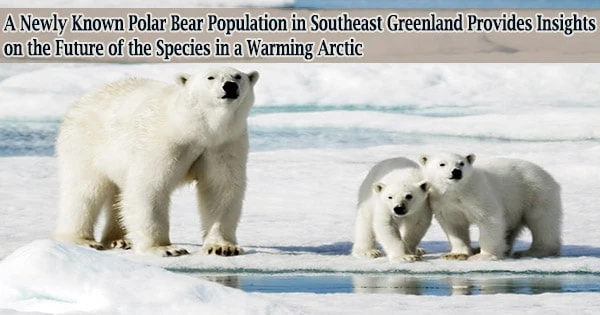Southeast Greenland is home to a hitherto unrecognized subpopulation of polar bears, according to researchers. The polar bears hunt on the freshwater ice that Greenland’s glaciers dump into the ocean in order to survive when they have little access to sea ice. Studying this isolated population could provide insight into the species’ future in the warming Arctic because it is genetically distinct and specially adapted to its surroundings.
“We wanted to survey this region because we didn’t know much about the polar bears in Southeast Greenland, but we never expected to find a new subpopulation living there,” said lead author Kristin Laidre, a polar scientist at the University of Washington’s Applied Physics Laboratory. “We knew there were some bears in the area from historical records and Indigenous knowledge. We just didn’t know how special they were.”
The study, which was released in Science on June 17, combines seven years of fresh data gathered along Greenland’s southeast coast with 30 years of historical data from the entire island’s east coast.
Due to its distant location, mountainous terrain, and severe snowfall, the far Southeast had received little research. These bears have restricted access to sea ice, which is demonstrated by the newly gathered genetic, mobility, and population data. These bears rely on glacier ice to survive.
“Polar bears are threatened by sea ice loss due to climate change. This new population gives us some insight into how the species might persist into the future,” said Laidre, who is also a UW associate professor of aquatic and fishery sciences. “But we need to be careful about extrapolating our findings because the glacier ice that makes it possible for Southeast Greenland bears to survive is not available in most of the Arctic.”
The genetic distance between this population of bears and its closest genetic neighbor is bigger than any of the 19 other polar bear groups that have been previously identified.
“They are the most genetically isolated population of polar bears anywhere on the planet,” said co-author Beth Shapiro, a professor, and geneticist at the University of California, Santa Cruz and investigator at the Howard Hughes Medical Institute. “We know that this population has been living separately from other polar bear populations for at least several hundred years and that their population size throughout this time has remained small.”
Polar bears are threatened by sea ice loss due to climate change. This new population gives us some insight into how the species might persist into the future. But we need to be careful about extrapolating our findings because the glacier ice that makes it possible for Southeast Greenland bears to survive is not available in most of the Arctic.
Kristin Laidre
Researchers think that one factor contributing to the population’s isolation is the bears’ encirclement on all sides, including by the East Greenland coastal current that poses a threat offshore, the open water of the Denmark Strait, and the massive Greenland Ice Sheet to the west and east, respectively.
Before beginning the fieldwork, the crew spent two years consulting with and learning from East Greenland’s subsistence polar bear hunters. Hunters took involved in the entire project, lending their knowledge and harvest samples for genetic analysis.
The satellite tracking of adult females reveals that Southeast Greenland bears are domesticated, in contrast to the majority of other polar bears that travel great distances over sea ice to hunt. They traverse the Greenland Ice Sheet by walking on ice inside safe fjords or climbing mountains to access nearby fjords.
On small ice floes caught in the East Greenland coastal current, half of the 27 tracked bears accidentally floated an average of 120 miles (190 kilometers) south, but they quickly got off and traveled back north on land to their home fjord.
“In a sense, these bears provide a glimpse into how Greenland’s bears may fare under future climate scenarios,” Laidre said. “The sea ice conditions in Southeast Greenland today resemble what’s predicted for Northeast Greenland by late this century.”
Only four months, from late February to late May, are available for Southeast Greenland bears to reach sea ice. The majority of the 26,000 polar bears that inhabit the Arctic hunt seals on sea ice.
Polar bears, however, are unable to fast for eight months. For two-thirds of the year, the Southeast Greenland polar bears rely on a different strategy: They hunt seals from chunks of freshwater ice breaking off the Greenland Ice Sheet.
“The marine-terminating glaciers in Southeast Greenland are a fairly unique environment,” said co-author Twila Moon, deputy lead scientist at the National Snow and Ice Data Center. “These types of glaciers do exist in other places in the Arctic, but the combination of the fjord shapes, the high production of glacier ice and the very big reservoir of ice that is available from the Greenland Ice Sheet is what currently provides a steady supply of glacier ice.”
Given that bears can live here, it is possible that some polar bears could survive when sea ice on the ocean’s surface decreases. This is especially true of marine-terminating glaciers that routinely calve ice into the ocean.
On other portions of the coast of Greenland as well as the island of Svalbard, a Norwegian territory situated east of Greenland, similar habitats can be found at marine-terminating glaciers.
“Even with rapid changes happening on the ice sheet, this area in Greenland has the potential to continue to produce glacial ice, with a coast that may looks similar to today, for a long time,” Moon said.
Similar to other tiny populations, the authors estimate that Southeast Greenland has a few hundred bears. Adult females appear to be smaller than in other regions, according to body measurements. They also have fewer cubs, which may be a result of the difficulty in locating partners in the challenging environment of the highlands and fjords.
However, Laidre stressed that longer-term monitoring is required to determine Southeast Greenland bears’ future sustainability and to comprehend what happens to polar bear subpopulations as they grow more and more isolated from the rest of the Arctic due to dwindling sea ice.
“If you’re concerned about preserving the species, then yes, our findings are hopeful I think they show us how some polar bears might persist under climate change,” Laidre said. “But I don’t think glacier habitat is going to support huge numbers of polar bears. There’s just not enough of it. We still expect to see large declines in polar bears across the Arctic under climate change.”
Any management and protection measures will be determined by the Greenland government. Southeast Greenland bears are the 20th population in the world to be subject to international recognition by the International Union for Conservation of Nature, which helps manage protected species.
“Preserving the genetic diversity of polar bears is crucial going forward under climate change,” Laidre said. “Officially recognizing these bears as a separate population will be important for conservation and management.”
This research was funded by NASA, the U.S. National Science Foundation, the government of Denmark; the government of Greenland; the UW; the University of Oslo; the Leo Model Foundation, and the Vetlesen Foundation.
Other co-authors are Eric Regehr, Benjamin Cohen and Harry Stern at the UW; Megan Supple, Christopher Vollmers and Russ Corbett-Detig at UC Santa Cruz; Erik Born, Fernando Ugarte, Peter Hegelund and Carl Isaksen at the Greenland Institute of Natural Resources; Oystein Wiig at the University of Oslo; Jon Aars at the Norwegian Polar Institute; Rune Dietz and Christian Sonne at Arhus University in Denmark; Geir Akse, a helicopter pilot in Norway; and David Paetkau at Wildlife Genetics International in Canada.
















